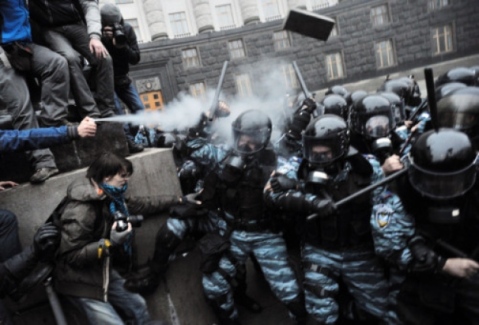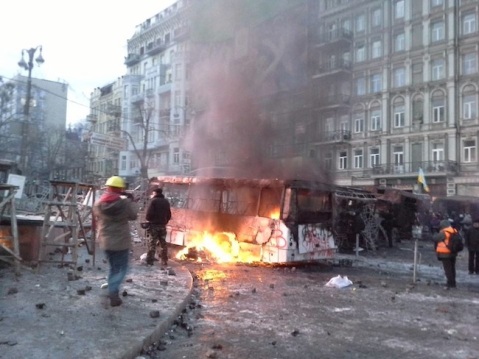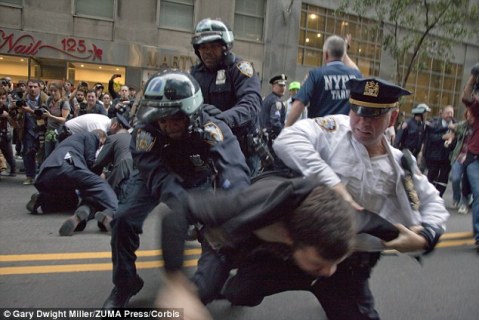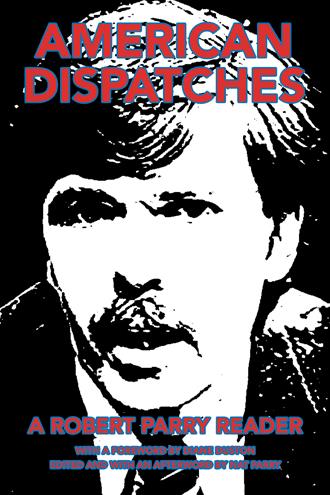Ignoring right-wing elements, U.S. hypocritically blames Ukrainian government for Kyiv violence

Protesters clash with police in Ukraine on November 24, 2012, following President Yanukovych’s announcement he would not sign the EU Association Agreement.
The escalating crisis in Ukraine, triggered by President Viktor Yanukovych’s decision in late November to forego closer ties with the EU in favor of strengthening ties with Moscow, has reached a boiling point in the Ukrainian capital Kyiv, with intense clashes between protesters and police over the weekend.
Following Yanukovych’s decision on Saturday to sign a new set of laws criminalizing some tactics of the pro-EU movement and clamping down on NGOs that receive funding from foreign sources, violence erupted when police tried to stop hardliners from marching on government buildings.
The demonstrators threw Molotov cocktails, attacked officers with sticks, stones, and flares, and set police buses on fire. The police threw stun grenades and tear gas and fired water cannons.
The Ukrainian interior ministry said 60 policemen were injured, while newswires report 40 or so protesters hurt. The violence on the part of the protesters was at times vicious, as seen in this video footage of demonstrators beating two police officers:
Ukrainian opposition leader and former boxing champion Vitali Klitschko was also assaulted by demonstrators when he tried to prevent protesters and riot police from clashing Sunday. Klitschko was sprayed with a fire extinguisher by the same protesters he had been rallying for weeks in an attempt to overthrow the government.
Although the situation in Ukraine has been volatile for some time, with sporadic outbreaks of violence committed by both protesters and police throughout December and January, the United States was quick to lay the blame for the new escalation of violence squarely with the Ukrainian authorities.
“The increasing tension in Ukraine is a direct consequence of the government failing to acknowledge the legitimate grievances of its people,” the White House said in a statement on Sunday.
Instead, it has moved to weaken the foundations of Ukraine’s democracy by criminalizing peaceful protest and stripping civil society and political opponents of key democratic protections under the law. We urge the government of Ukraine to take steps that represent a better way forward for Ukraine, including repeal of the anti-democratic legislation signed into law in recent days, withdrawing the riot police from downtown Kyiv, and beginning a dialogue with the political opposition.
From its first days, the Maidan movement has been defined by a spirit of non-violence and we support today’s call by opposition political leaders to reestablish that principle. The U.S. will continue to consider additional steps — including sanctions — in response to the use of violence.
The White House statement followed similar remarks by Victoria Nuland, Assistant Secretary of State, at the Senate Foreign Relations Committee last week. Asserting that demonstrators in Ukraine have been nonviolent, she said, “The whole world has watched the peaceful protest of hundreds of thousands of Ukrainians on the Maidan in Kyiv and tens of thousands in other cities across Ukraine.”
She noted that protesters were first inspired by the government’s decision to halt the Association Agreement negotiations with the European Union, but claimed that their resolve “deepened and broadened into something much more in the ensuing weeks as events snowballed.”
These included, she said, “the violent attempt by security forces to clear the Maidan of protestors on November 30 and the lack of government accountability that followed; the second attempt to use security forces to shut down the Maidan in the wee hours of December 11; and finally the Ukrainian government’s decision to accept $15 billion in Russian bail-out money.”
What is completely absent from her “analysis” is the role played by far-right hardliners in Ukraine, who have had a deep influence over the direction of the protests from the beginning.
One of the early outbreaks of violence in Kyiv was on December 1, when clashes broke out on Bankova Street near the building of the Presidential Administration, where the special Ukrainian police force, the Berkut, held a line against hundreds of violent demonstrators. The protesters threw flares, smoke bombs, Molotov cocktails and stones at the police, beat them with chains, fired tear gas, and brought up an excavator to break through the police cordon.
![Protesters use a tractor to break through police lines near the president's office on Dec. 1, 2013. [Reuters]](https://compliancecampaign.files.wordpress.com/2014/01/kyiv-tractor.jpg?w=479)
Protesters use a tractor to break through police lines near the president’s office on Dec. 1, 2013. [Reuters]
Since the opposition had specifically renounced any use of violence, the media soon started to refer to these men as “provocateurs.” An analyst at OpenDemocracy.net, however, said that the situtation is more complicated.
“What is clear,” wrote Anton Shekhovtsov on 3 December, “is that the hardcore of the violent crowd was not the titushki [provocateurs], but right-wing extremists and far right football hooligans. Almost all of them wore masks and yellow armbands with the wolf’s hook symbol; and were clearly battle-equipped.”
Shekhovtsov pointed out that the black wolf’s hook on yellow armbands indicated their political affiliation: the Social-National Assembly (SNA), a neo-Nazi organization. In addition to the SNA, the violent extremists likely included members of ‘Tryzub’ (Trident) and ‘Bily Molot’ (White Hammer).
The U.S., however, appears more than happy to ignore those elements and place all the blame for Ukraine’s escalating violence with the government. In explaining why the outcome of the struggle in Ukraine matters to the United States, Victoria Nuland claimed last week that “these same principles and values are the cornerstone of all free democracies, and America supports them in every country on the planet.”
The Ukrainian protesters, she said, “are all calling for the same basic rights we hold dear here in the United States. They want to live in a country where their government truly represents the wishes of the people and where they can safely exercise their rights without the fear of oppression.”
Ironically, on the same day that Nuland was offering this testimony to the Senate Foreign Relations Committee, the largest civil rights settlement for protest-related mass arrests in U.S. history was being handed down in New York City.
After nearly a decade of legal wrangling, the deal reached last Wednesday offered some degree of justice — albeit delayed — for more than 1,800 peaceful protesters arrested during the 2004 Republican National Convention in New York. The settlement comes 15 months after a ruling by a federal judge in September 2012, which determined that “there was no probable cause to arrest protestors.”
Yet, some said that the agreement was bittersweet.
“This settlement is not justice, but it is positive closure,” Zachary Miller, who attended the RNC protests as a journalist with the Urbana-Champaign, Illinois Independent Media Center and was held for 23 hours after being swept up in a mass arrest, told Common Dreams.
“Settlements are symbolic and will never curb repression,” said Barucha Peller, who was also arrested at the protests.
Indeed, after spending almost $16 million dollars of taxpayer money defending itself during nearly ten years of litigation, the New York Police Department has continued to violate protesters’ civil rights, most notably in the violent crackdown on Occupy Wall Street in 2011 and 2012.
In an attempt to clear out a downtown encampment in November 2011, the NYPD, decked out in riot gear with batons drawn, used teargas and “sonic cannon” crowd control weaponry to attack peaceful protesters. About a dozen demonstrators were injured. One 19-year-old protester was photographed being taken away with blood dripping down his face, with a possible skull injury resulting from a baton strike to the head. Witnesses saw police push protesters to the ground and one young woman was reportedly dragged away by police by her hair.
As CBS News reported at the time, “some of these altercations … seemed unprovoked. Others appeared touched off in part by protesters removing barricades erected to control the demonstrations. But in both cases the level of violence suggested, at best, indiscipline by individual cops and at worst official license to cause bodily harm.”
On the other side of the country, Oakland police used “an overwhelming military-type response” to disperse Occupy Oakland demonstrators in October 2011 and intentionally fired at Iraq war veteran Scott Olsen who was critically injured in the protests, according to a report issued by an outside monitor of the Oakland Police Department.
Video taken of the October events shows that when fellow demonstrators went to the aid of Olsen, another cop threw a flash grenade into the crowd, further endangering the injured protester and those who were coming to his aid.
In response, Human Rights Watch issued a statement calling on police to respect the fundamental rights of Occupy Wall Street demonstrators across the country.
“The United States’ tradition of peaceful protest is protected not only in U.S. law but also under international law,” said Alison Parker, U.S. program director at Human Rights Watch. “Even when protesters’ actions warrant police intervention, force should only be used where strictly necessary and then only to the degree necessary.”
Amnesty International also weighed in, urging authorities “to ensure that police show restraint in their response to Occupy Wall Street protests, following critical injuries suffered by a man in Oakland, Ca. in clashes between police and demonstrators.”
“The increasingly heavy-handed policing tactics used to quell the Occupy Wall Street protests are deeply alarming,” said Guadalupe Marengo, deputy program director for the Americas. “The police must not resort to using excessive force, such as tear gas, unless strictly necessary.”
All in all, nearly 8,000 overwhelmingly peaceful protesters were arrested over two years of Occupy Wall Street-related protests.
At the height of the Occupy movement, public opinion surveys indicated that 79% of Americans agreed with the protesters’ main grievances, particularly the statement that the “The big banks got bailed but the middle class got left behind.” On the other hand, when it comes to the political crisis in Ukraine, the situation is much murkier.
As far as the primary issue that sparked the demonstrations in Kyiv — the decision by the Ukrainian government to forgo the EU Association Agreement in favor of the Moscow-led Customs Union — the Ukrainian public seems rather evenly split, and seems to understand that there are complex geopolitical and economic concerns that the government is trying to balance.
Among the findings of a public opinion poll from December, conducted by the Research & Branding Group on Euromaidan 2013, include the following:
Despite this more nuanced and complicated picture, U.S. officials are not hesitating to paint this issue as black-and-white, with the Kyiv protesters righteously defending the will of the people, and the authorities attempting to violently crush Ukraine’s democratic aspirations.
Ukrainians “want to live in a country where their government truly represents the wishes of the people and where they can safely exercise their rights without the fear of oppression,” Victoria Nuland said last week.
Perhaps if she also spoke out on behalf of U.S. protesters repressed by their government, it would be easier to take her comments seriously, but as it stands, it looks obvious that U.S. policy towards Ukraine is just another attempt to undermine the foreign policy goals of the Yanukovych government and Russia — as well as any country not within the U.S. sphere of influence.





